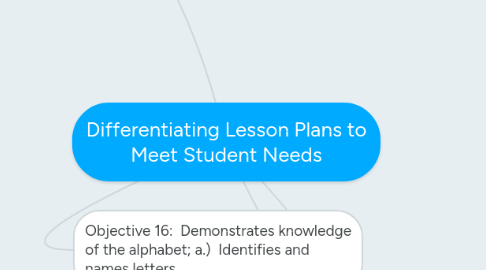
1. Group A: The children in this group have little to no exposure to the alphabet
1.1. Child A has not been exposed to the alphabet and this is her first experience in a preschool setting. She is learning how to be a students and participate in group activities. Child A is enjoying school and likes to play games.
1.2. Strategy 1: The children will be exposed to the letters in their name through classroom games/transition times.
1.2.1. Activity 1: Children will be prompted to identify letters when they are being dismissed. The teacher will hold up letter and say, "The person, whose name starts with an A, can now line up." If needed, the teacher will assist individual children. For an extra challenge, the teacher can start with the second letter, for children who have had more exposure.
1.2.2. Activity 2: During choice time, the children will be given the option to play with play dough and letters. The teacher leading the group will prompt the children to use their name cards to find the letters in their name. Once they find their letters, the children will then be asked to place the letters into the correct order and stamp the letters into the play dough.
1.3. Strategy 2: During small group time, the teacher will use letter recognition games to assess where individual children are at with their letters and teach.
1.3.1. Activity 1: The children will use a template that has the letters of their name with a little box underneath the letter. At the table, their will be foam letter available for the children to match the foam letter with the letter on the template in the box.
1.3.2. Activity 2: The children will be given a newspaper with a sentence strip that has their name on it. Each child will be prompted to look in the newspaper for the letters in their name. The children will have markers to circle the letters and a magnifying glasses.
1.3.3. Activity 3: The children will play a letter identification game on the Ipad. On the Ipad, the children will be prompted to play a game through the Hand Writing without Tears curriculum that Head Start uses. A group of letters will pop up on the screen, and the children will be asked to identify one letter out of the group. The teacher running the small group can determine which letters individual children will see.
2. Children will be able to identify at least ten letters, specifically letters in their own name.
3. Objective 16: Demonstrates knowledge of the alphabet; a.) Identifies and names letters.
4. Group B: Children that already know the order and all the letters in their name.
4.1. Child B knows all the letters in his first name. He is working on identifying letters in his last name and is ready to start producing sounds of consonants. Child B enjoys choice time activities and works well with children that are at the same level as him. For these activities, this child would be encouraged to work with the children in his group to challenge him further.
4.2. Strategy 1: Literacy stations will be set-up in the classroom during choice time for children who need an extra challenge.
4.2.1. Activity 1: During choice time, a literacy center with different letters, manipulatives, and play dough will be available for the children. A teacher will sit at this center and run the center. The teacher will prompt the children that are learning more than the first ten letters in their name to identify other letters while playing.
4.2.2. Activity 2: The children in this group will be prompted to join a game at the literacy center that focuses on finding the letters and matching them with the letter on the table. For example, the teacher will call out a letter and have the children find that letter on table. The teacher will also have the children work with letters that are not in their name, and have the identify the letters.
4.2.3. Activity 3: For this activity, the classroom computer games who be focused on literacy and letter identification. In my current classroom, I have a Hatch computer that focuses on individual children's learning goals and themes for that week.
4.3. Strategy 2: At small groups, this group of children will work with a teacher individually to learn more letters.
4.3.1. Activity 1: The children will find the letters of their last name with a sentence stripe that has their name written out and a collection of letters that can be sorted.
4.3.2. Activity 2: At this group, the children will look for letters that are scattered about the classroom. They will be given a chart of letters that they can check off as they find letters.

